Pragyan Mohanty1, Kunchok Dolma J1, Anil Kumar Gujjari2, Sai Krishna D4, Sheela Kumar Gujjari4*, Kritika Banerjee5
1MDS, Ex- PG student, Department of Periodontology, JSS Dental College, Mysuru, India
2Professor, Department of Prosthodontics, JSS Dental College, Mysuru, India
3Professor, Department of Oral and Maxillofacial Surgery, JSS Dental College, Mysuru, India
4Professor, Department of Periodontology, JSS Dental College, Mysuru, India
5PG student, Department of Periodontology, JSS Dental College, Mysuru, India
*Corresponding Author: Sheela Kumar Gujjari, Professor, Department of Periodontology, JSS Dental College, Mysuru, India; Email: [email protected]
Published Date: 01-06-2022
Copyright© 2022 by Gujjari SK, et al. All rights reserved. This is an open access article distributed under the terms of the Creative Commons Attribution License, which permits unrestricted use, distribution, and reproduction in any medium, provided the original author and source are credited.
Abstract
Loss of teeth in the anterior region in a young patient can be very traumatic. Not only are they concerned about the function, but also about the aesthetics. The rehabilitation of missing teeth poses the challenge of deficiency of both hard and soft tissues. This case report highlights the rehabilitation of the teeth in the aesthetic zone of a patient who had lost teeth due to a road traffic accident. An inter-disciplinary approach was used to treat this patient. Alveolar ridge was augmented prior to implant placement. The ridge deficiency was successfully augmented with autogenous bone graft, which laid a strong foundation for the osseointegration for implant placement and the patient was satisfied with the functional and aesthetic outcome, which was measured using the Pink Esthetic score and White Esthetic Score.
Keywords
Bone Graft; Electric Pulp Test; Implants; Tobacco Consumption
Introduction
Dental traumatic injuries are very common among young children and adolescents that usually results from accidents, contact sports, falls and violence [1]. According to Martins, et al., the main etiologic factors of dental injury in the permanent dentition are fights, sports injuries and motor vehicle collision [2]. While in primary dentition, falls against hard objects are the most frequent cause. These injuries can lead to either subluxation or avulsion of tooth.
Management of such concomitant dental injuries are found to be challenging. A coordinated effort or an interdisciplinary approach is required for an appropriate diagnosis and effective patient care.
If the avulsed tooth can be stored in saliva or saline and brought to the dentist in 20-30 minutes, then an immediate reimplantation can be attempted. In situations where, the tooth has not been stored properly and brought to the dentist, newer approaches need to be considered, for example, implants.
The alveolar bone often undergoes resorption and alveolar ridge insufficiency may require an augmentation to support an implant, thereby requiring a 2-step procedure. Various techniques are present for augmentation of the alveolar ridge including distraction osteogenesis and ridge split technique, however, regeneration using various bone grafts and barrier membranes for guided bone regeneration remains the most frequently used option. The resorption of the bone can compromise the aesthetic, functional and structural aspect of the treatment [3,4].
So, to arrive at this goal, augmentation and regeneration of the lost bone is pivotal. The Pink and White Esthetic Scores should be in harmony to achieve success in the soft and hard tissue restoration.
Platelet Rich Fibrin has found to have great healing potential for hard and soft tissue regeneration. It has no inflammatory effects and can be used with all kinds of graft materials and when used as a membrane, it aids in stimulating healing by increasing vascularization and collagen production.
Case Presentation
A 28yrs old male patient had come with a chief complaint of pain and missing teeth in the maxillary front teeth region. The patient gave a history of a road traffic accident 3 months back. A thorough medical history was recorded, the patient was found to be systemically healthy, with no habit of smoking and tobacco consumption (Fig.1).
On clinical examination, avulsion of 11 and 12 and 21- Ellis class II fracture with grade I mobility were noted. Electric Pulp Test of 21 revealed negative response (non-vital) and extrusive luxation was noted.
Radiographs (OPG and CBCT) revealed horizontal dento-alveolar fracture mesial to 21 and alveolar ridge resorption w.r.t. 11 and 12 (labial) (Fig.2).
Phase 1 periodontal therapy was performed. Coronoplasty was also performed to relieve trauma from occlusion. Composite splinting was done using ligature wire for intrusion of 21, followed by root canal treatment of 21 simultaneously.
Patient was informed about the need for horizontal alveolar ridge augmentation and implant placement, advised blood investigations and surgical consent was taken before the surgical procedure.
Surgical Procedure
2% Lidocaine with 1:80000 adrenaline was used to anesthetize the site of operation. A horizontal incision and two vertical releasing incisions were given on the mid alveolar crest followed by reflection of a full thickness flap. Cortication was done at the recipient site using a small round bur for accelerated vascularization of the graft.
A rectangular corticocancellous graft was taken from the chin region using a surgical bur, shaped, positioned and firmly anchored in the 11and12 region with 2 titanium screws (2×10 mm). The edges of the graft were filled with hydroxyapatite grafting material and a PRF membrane was placed over it.
Tension free flap closure was done with horizontal mattress using resorbable sutures and covered with a periodontal dressing.
Analgesics, antibiotics and an antimicrobial mouth rinse was prescribed for 1 week (Fig. 3).
Patient was monitored for repetitive follow ups. Temporary prosthesis was given w.r.t. 11 and 12. After 4 months, postoperative examination showed increased width of alveolar ridge (Fig. 4). So, the surgical screw was removed and alloplastic graft was placed in the cortical perforation caused by the surgical screws.
Patient was recalled and advised for CBCT scan after 3 months, which revealed good bone support and dental implants for prosthetic rehabilitation was confirmed. Under local anesthesia and the site was re-entered for placement of the implants using temporary RPD as a surgical guide for initial drill.
A full thickness flap was raised and two endosseous implants (3.3 x 8 mm) were placed along with cover screws w.r.t. 11 and 12 (Fig. 5). Flap was then approximated and interrupted sutures was given for primary wound closure and periodontal dressing was given. Analgesics, antibiotics and an antimicrobial mouth rinse was prescribed for 1 week.
Four months after implant placement, periapical radiograph revealed successful osseointegration. A 2-stage surgery was performed where the cover screw was removed and gingival former was placed over the implant forming a gingival cuff around the implant. 2 weeks after this, straight abutments were screwed to the implant fixture and abutment level impressions were made using closed-tray impression technique with polyvinyl siloxane impression material and master cast was fabricated followed by the laboratory procedures. After casting, bisque trial was verified in both centric and eccentric movements. Finally, porcelain fused to metal crowns were cemented onto the implants using luting cement (Fig. 6).
The patient was followed for a period of 3 years (Fig.7).

Figure 1: Pre-operative.

Figure 2: Radiographic examination revealed horizontal fracture and ridge resorption in maxillary anterior region.
Figure 3: Rectangular corticocancellous block graft harvested from the symphysis region using trephine bur, shaped, positioned firmly in the 11 and 12 region and anchored using titanium screws (2×10 mm).

Figure 4: After 4 months, examination showed an increase in the width of alveolar ridge at the grafted site.

Figure 5: Two endosseous implants (3.3×8 mm) were placed with cover screws w.r.t. 11 and 12.

Figure 6: Post-op.

Figure 7: 3 years follow up.
Discussion
Autogenous bone grafts is the gold standard among various bone grafts. It not only has osteoinductive activity due to production of growth factors, but also osteoconductive ability thereby acting as a space filler. It has advantages over other augmentation techniques including short healing time, favorable bone quality, lower material cost, no risk of disease transmission or antigenicity. Moreover, denser cortical bone grafts exhibit less resorption making them suitable for site development in implant placement [5].
Platelet-Rich Fibrin (PRF) is a second-generation platelet concentrate, containing active platelets and leukocytes. It can be used by itself, compressed to get a PRF membrane or mixed with grafts and biomaterials. It effects the healing of hard and soft tissue by the release of growth factors. The PRF membranes can be used as a mechanical barrier, protecting open wounds and preventing infections [6]. Particulate and monocortical grafts were used in this case and despite being considered the gold standard among bone grafts, which include, morbidity of donor site and a potential for resorption [7].
After graft placement, PRF membrane was placed over it. The natural fibrin framework present in PRF helps in retaining the growth factors present in it. These growth factors on turn help to reduce limitations like donor site morbidity of bone graft, improving its longevity [8].
Adequate amounts of bone and soft tissue is paramount for increasing the longevity of dental implants. Augmentation of soft and hard tissue allows clinicians to meet biological, functional and esthetic requirements for dental implants to succeed in the maxillary anterior region [9,10].
The esthetic component of an implant is dictated by the soft tissue framing, which is defined as the gingival contour that surrounds the prosthesis. The Pink Esthetic Score (PES) evaluates the esthetic outcome of soft tissue around implant-supported single crowns in the aesthetic zone and the White Esthetic Score (WES) was used to evaluate the esthetic outcome with regard to the quality of the implant crown. Assessment is done using a point system; points are given for the mesial and distal papilla, soft-tissue level, soft-tissue contour, soft-tissue color, soft-tissue texture and alveolar process deficiency for PES and for WES, points are given for tooth form, tooth volume/outline, colour, surface texture, translucency [11,12]. A considerable amount of horizontal augmentation was achieved along with desirable prosthetic outcomes in this case. The patient was satisfied with the functional and aesthetic outcome achieved even after 3 years.
Conclusion
Oral rehabilitation in the 21st century is a matter of skilful diagnosis and minimal yet appropriate intervention, the nature of which is intimately linked to a profound knowledge of oral physiology, oral biology, dental and oral pathology. Therefore, interdisciplinary approach plays a very crucial role in the rehabilitation of the teeth and to provide quality dental care to the patients.
Conflict of Interest
There are no conflicts of interest.
References
- Andreasen JO, Andreasen FM, Andersson L. Textbook and color atlas of traumatic injuries to the teeth. 4th Oxford: Blackwell. 2007.
- Martins WD, Ditzel, Westphalen VP, Westphalen FH. Dental, Avulsed tooth. Dent Traumatol. 2005;75:14-36.
- McAllister BS, Haghighat K. Bone augmentation techniques. J Periodontol. 2007;78:377-96.
- Schropp L, Wenzel A, Kostopoulos L, Kar-ring T. Bone healing and soft tissue contour changes following single tooth extraction: a clinical and radiographic 12-month prospective study. Int J Periodontics Restorative Dent. 2003;23:313-23.
- Jeng MD, Chiang CP. Autogenous bone grafts and titanium mesh-guided alveolar ridge augmentation for dental implantation. J Dent Sci. 2020;15(3):243-8.
- Dohan Ehrenfest DM, Andia I, Zumstein MA, Zhang CQ, Pinto NR, Bielecki T. Classification of platelet concentrates (Platelet-Rich Plasma-PRP, Platelet-Rich Fibrin-PRF) for topical and infiltrative use in orthopedic and sports medicine: current consensus, clinical implications and perspectives. Muscles Ligaments Tendons J. 2014;4(1):3-9.
- Misch, Craig M. Autogenous bone: is it still the gold standard? Implant Dent. 2010;19(5):361.
- Hafez WA, Seif SA, Shawky H, Hakam MM. Platelet rich fibrin as a membrane for coverage of immediate implants: Case series study on eight patients. Tanta Dental J. 2015;12(3):203-10.
- Maiorana C, Ferrario S, Poli PP, Manfredini M. Autogenous chin block grafts in the aesthetic zone: a 20-year follow-up case report. Case Rep Dent. 2020;2020:6525797.
- Paolantoni G, Marenzi G, Fusco A, Sammartino G. Implant rehabilitation of central incisor: a staged approach. Implant Dent. 2007;16(4):349-55.
- Gehrke P, Lobert M, Dhom G. Reproducibility of the pink esthetic score-rating soft tissue esthetics around single-implant restorations with regard to dental observer specialization. J Esthetic Restorative Dent. 2008;20:375-84.
- Altay MA, Sindel A, Tezerişener HA. Esthetic evaluation of implant-supported single crowns: a comparison of objective and patient-reported outcomes. Int J Implant Dent. 2019;5:2.
Article Type
Case Report
Publication History
Received Date: 07-05-2022
Accepted Date: 25-05-2022
Published Date: 01-06-2022
Copyright© 2022 by Gujjari SK, et al. All rights reserved. This is an open access article distributed under the terms of the Creative Commons Attribution License, which permits unrestricted use, distribution, and reproduction in any medium, provided the original author and source are credited.
Citation: Gujjari SK, et al. Alveolar Ridge Augmentation with Implant Placement in the Anterior Maxilla: A Case Report. J Dental Health Oral Res. 2022;3(2):1-9.
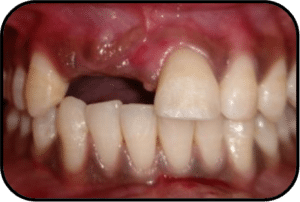
Figure 1: Pre-operative.
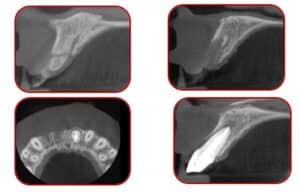
Figure 2: Radiographic examination revealed horizontal fracture and ridge resorption in maxillary anterior region.
Figure 3: Rectangular corticocancellous block graft harvested from the symphysis region using trephine bur, shaped, positioned firmly in the 11 and 12 region and anchored using titanium screws (2×10 mm).
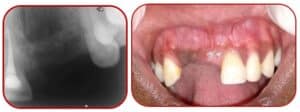
Figure 4: After 4 months, examination showed an increase in the width of alveolar ridge at the grafted site.
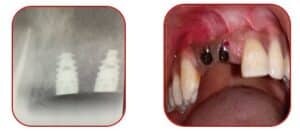
Figure 5: Two endosseous implants (3.3×8 mm) were placed with cover screws w.r.t. 11 and 12.

Figure 6: Post-op.
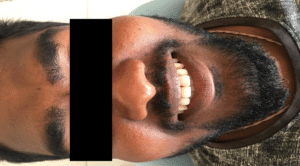
Figure 7: 3 years follow up.


